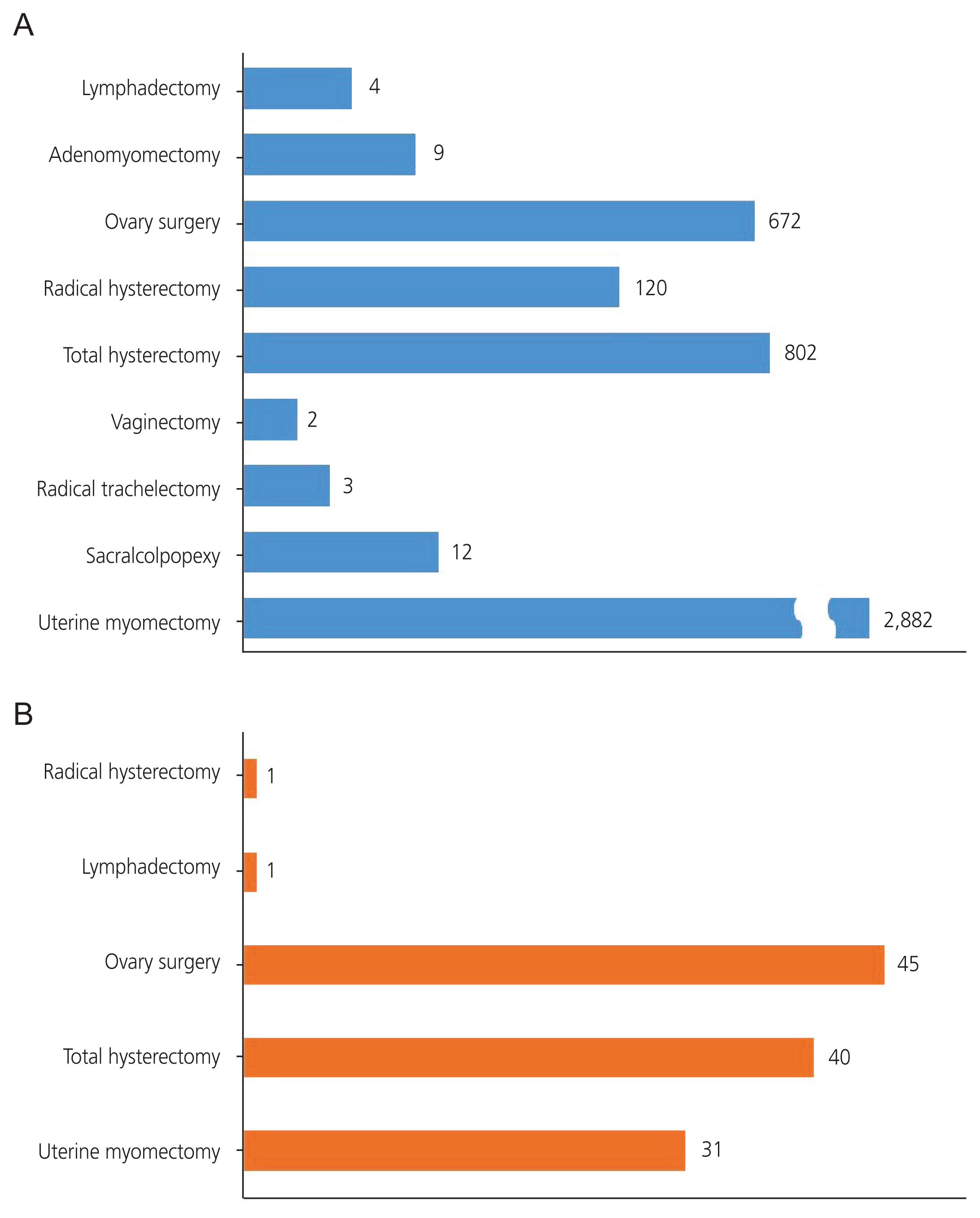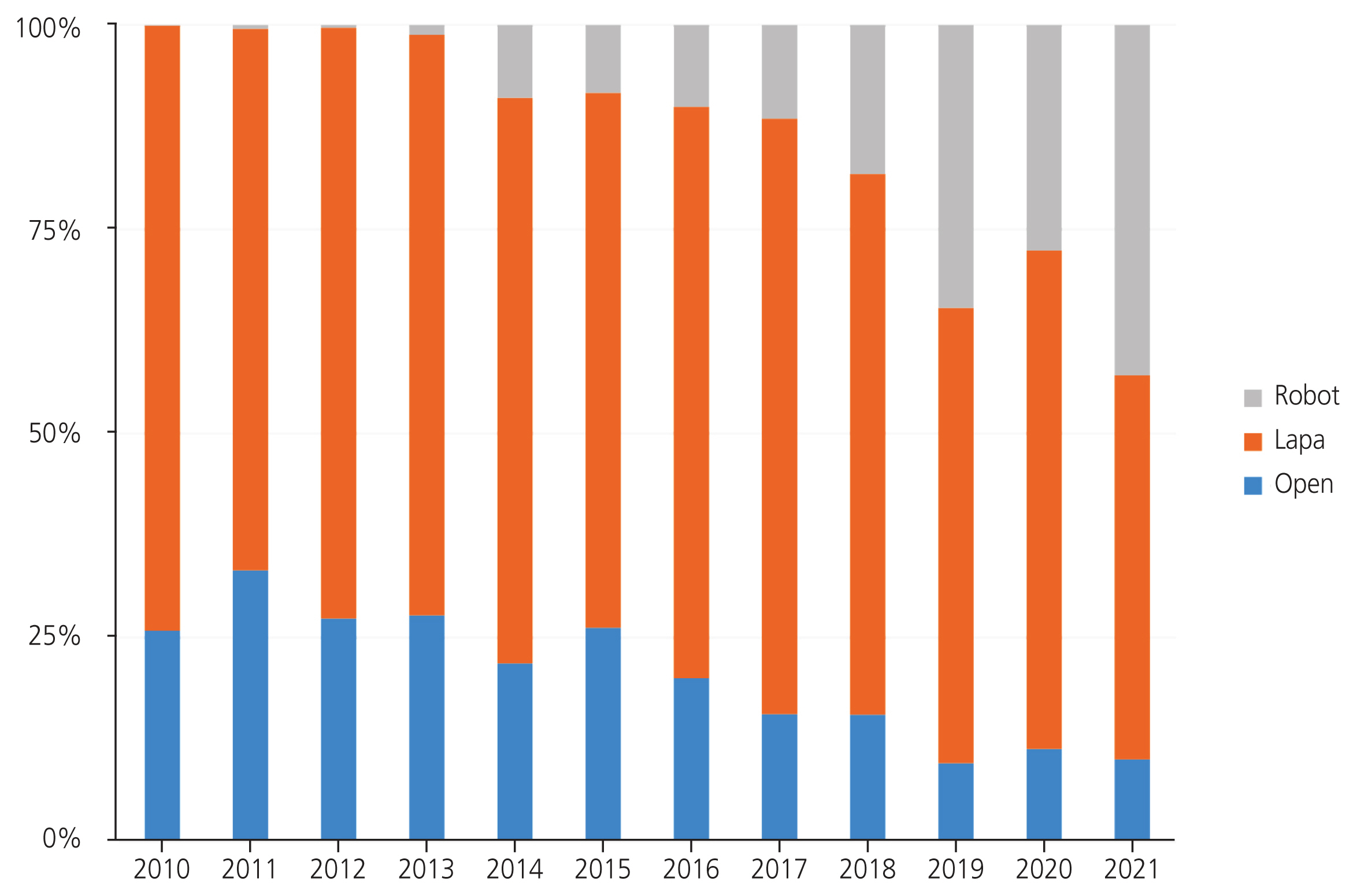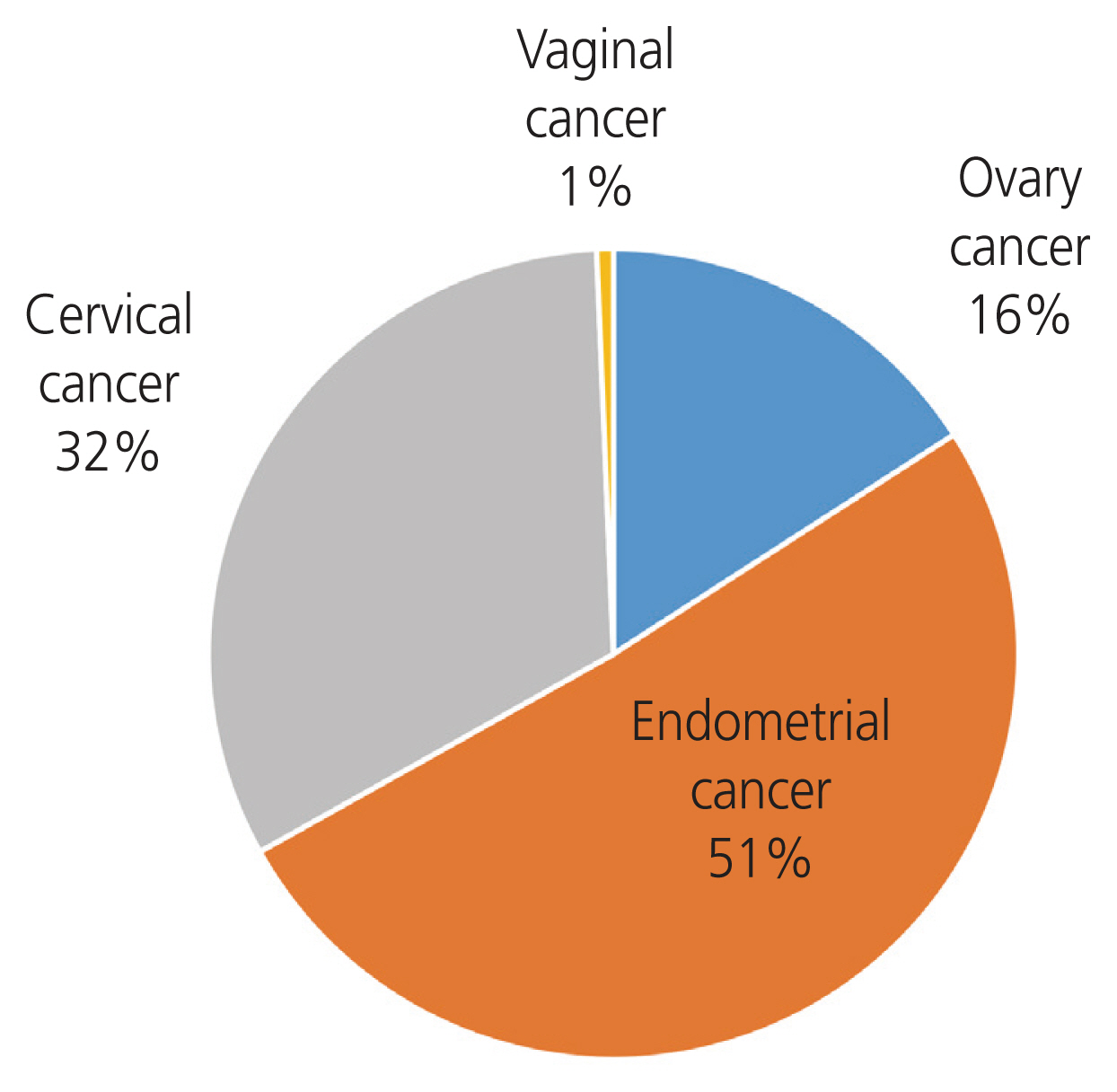Obstet Gynecol Sci.
2023 Nov;66(6):518-528. 10.5468/ogs.23132.
Robotic surgery in Gynecology: the present and the future
- Affiliations
-
- 1Department of Obstetrics and Gynecology, Seoul St. Mary’s Hospital, College of Medicine, The Catholic University of Korea, Seoul, Korea
- 2Department of Obstetrics and Gynecology, Bucheon St. Mary’s Hospital, College of Medicine, The Catholic University of Korea, Seoul, Korea
- 3Department of Obstetrics and Gynecology, St. Vincent’s Hospital, College of Medicine, The Catholic University of Korea, Seoul, Korea
- 4Department of Obstetrics and Gynecology, Uijeongbu St. Mary’s Hospital, College of Medicine, The Catholic University of Korea, Seoul, Korea
- 5Department of Obstetrics and Gynecology, Eunpyeong St. Mary's Hospital, College of Medicine, The Catholic University of Korea, Seoul, Korea
- KMID: 2547853
- DOI: http://doi.org/10.5468/ogs.23132
Abstract
- Since its introduction, laparoscopic surgery has been often preferred over open surgery in obstetrics and gynecology due to its advantages, such as less bleeding, lower incidence of adhesions, reduced postoperative pain, short hospital stay, and quick return to daily life. However, in the case of complex surgeries, laparoscopy presented some limitations. Nonetheless, since the 1980s, medical robots have been introduced to overcome the technical limitations of laparoscopy and start a new age for minimally invasive surgery. In this review, we explore the indications and advantages and disadvantages of robotic surgery in the field of gynecology, and try to assess the recent trend of robotic surgery.
Keyword
Figure
Reference
-
References
1. Watrowski R, Kostov S, Alkatout I. Complications in laparoscopic and robotic-assisted surgery: definitions, classifications, incidence and risk factors - an up-to-date review. Wideochir Inne Tech Maloinwazyjne. 2021; 16:501–25.
Article2. Intuitive Corp. Intuitive annual report Intuitive Surgical, Inc [Internet]. Sunnyvale: Intuitive Corp;c2021. [cited 2023 Apr 18]. Available from: https://isrg.intuitive.com/static-files/704322bf-cb0d-4ed1-954c-8eb46a070f70 .3. Whiteman MK, Hillis SD, Jamieson DJ, Morrow B, Podgornik MN, Brett KM, et al. Inpatient hysterectomy surveillance in the United States, 2000–2004. Am J Obstet Gynecol. 2008; 198:34.e1–7.
Article4. Wright JD, Ananth CV, Lewin SN, Burke WM, Lu YS, Neugut AI, et al. Robotically assisted vs laparoscopic hysterectomy among women with benign gynecologic disease. JAMA. 2013; 309:689–98.
Article5. Aarts JW, Nieboer TE, Johnson N, Tavender E, Garry R, Mol BW, et al. Surgical approach to hysterectomy for benign gynaecological disease. Cochrane Database Syst Rev. 2015; 2015:CD003677.
Article6. Committee opinion no. 701 summary: choosing the route of hysterectomy for benign disease. Obstet Gynecol. 2017; 129:1149–50.7. Albright BB, Witte T, Tofte AN, Chou J, Black JD, Desai VB, et al. Robotic versus laparoscopic hysterectomy for benign disease: a systematic review and meta-analysis of randomized trials. J Minim Invasive Gynecol. 2016; 23:18–27.
Article8. Sarlos D, Kots L, Stevanovic N, von Felten S, Schär G. Robotic compared with conventional laparoscopic hysterectomy: a randomized controlled trial. Obstet Gynecol. 2012; 120:604–11.9. Silasi DA, Gallo T, Silasi M, Menderes G, Azodi M. Robotic versus abdominal hysterectomy for very large uteri. JSLS. 2013; 17:400–6.
Article10. Sohn GS, Cho S, Kim YM, Cho CH, Kim MR, Lee SR. Current medical treatment of uterine fibroids. Obstet Gynecol Sci. 2018; 61:192–201.
Article11. Zepiridis LI, Grimbizis GF, Tarlatzis BC. Infertility and uterine fibroids. Best Pract Res Clin Obstet Gynaecol. 2016; 34:66–73.
Article12. Wang T, Tang H, Xie Z, Deng S. Robotic-assisted vs. laparoscopic and abdominal myomectomy for treatment of uterine fibroids: a meta-analysis. Minim Invasive Ther Allied Technol. 2018; 27:249–64.
Article13. Cooper AR, Powell MA, Jimenez PT, Johnson MD, Rabinov A, Graseck AS. Discussion: ‘comparison of robotic and laparoscopic myomectomy’ by Bedient et al. Am J Obstet Gynecol. 2009; 201:e1–4.
Article14. Ahn SH, Park JH, Kim HR, Cho S, Lee M, Seo SK, et al. Robotic single-site versus multi-port myom4ectomy: a case-control study. BMC Surg. 2021; 21:264.15. Giudice LC. Clinical practice. Endometriosis. N Engl J Med. 2010; 362:2389–98.16. de Paula Andres M, Borrelli GM, Kho RM, Abrão MS. The current management of deep endometriosis: a systematic review. Minerva Ginecol. 2017; 69:587–96.
Article17. Becker CM, Bokor A, Heikinheimo O, Horne A, Jansen F, Kiesel L, et al. ESHRE guideline: endometriosis. Hum Reprod Open. 2022; 2022:hoac009.18. Magrina JF, Espada M, Kho RM, Cetta R, Chang YH, Magtibay PM. Surgical excision of advanced endometriosis: perioperative outcomes and impacting factors. J Minim Invasive Gynecol. 2015; 22:944–50.
Article19. Restaino S, Mereu L, Finelli A, Spina MR, Marini G, Catena U, et al. Robotic surgery vs laparoscopic surgery in patients with diagnosis of endometriosis: a systematic review and meta-analysis. J Robot Surg. 2020; 14:687–94.
Article20. Cela V, Obino ME, Sergiampietri C, Simi G, Papini F, Pinelli S, et al. The role of robotics in the management of endometriosis. Minerva Ginecol. 2017; 69:504–16.
Article21. Smith FJ, Holman CD, Moorin RE, Tsokos N. Lifetime risk of undergoing surgery for pelvic organ prolapse. Obstet Gynecol. 2010; 116:1096–100.
Article22. Seror J, Yates DR, Seringe E, Vaessen C, Bitker MO, Chartier-Kastler E, et al. Prospective comparison of short-term functional outcomes obtained after pure laparoscopic and robot-assisted laparoscopic sacrocolpopexy. World J Urol. 2012; 30:393–8.
Article23. Ploumidis A, Spinoit AF, De Naeyer G, Schatteman P, Gan M, Ficarra V, et al. Robot-assisted sacrocolpopexy for pelvic organ prolapse: surgical technique and outcomes at a single high-volume institution. Eur Urol. 2014; 65:138–45.
Article24. Dabreteau T, Delangle R, Azaïs H, Phé V, Moawad G, Uzan C, et al. Robot-assisted sacrocolpopexy for recurrent pelvic organ prolapse: insights for a challenging surgical setting. J Gynecol Obstet Hum Reprod. 2022; 51:102380.
Article25. Maher CM, Feiner B, Baessler K, Glazener CM. Surgical management of pelvic organ prolapse in women: the updated summary version Cochrane review. Int Urogynecol J. 2011; 22:1445–57.
Article26. Ramirez PT, Frumovitz M, Pareja R, Lopez A, Vieira M, Ribeiro R, et al. Minimally invasive versus abdominal radical hysterectomy for cervical cancer. N Engl J Med. 2018; 379:1895–904.
Article27. Walker JL, Piedmonte MR, Spirtos NM, Eisenkop SM, Schlaerth JB, Mannel RS, et al. Laparoscopy compared with laparotomy for comprehensive surgical staging of uterine cancer: Gynecologic Oncology Group Study LAP2. J Clin Oncol. 2009; 27:5331–6.
Article28. Kornblith AB, Huang HQ, Walker JL, Spirtos NM, Rotmensch J, Cella D. Quality of life of patients with endometrial cancer undergoing laparoscopic international federation of gynecology and obstetrics staging compared with laparotomy: a Gynecologic Oncology Group study. J Clin Oncol. 2009; 27:5337–42.
Article29. Feuer GA, Lakhi N, Barker J, Salmieri S, Burrell M. Perioperative and clinical outcomes in the management of epithelial ovarian cancer using a robotic or abdominal approach. Gynecol Oncol. 2013; 131:520–4.
Article30. Kumar S, Al-Wahab Z, Sarangi S, Woelk J, Morris R, Munkarah A, et al. Risk of postoperative venous thromboembolism after minimally invasive surgery for endometrial and cervical cancer is low: a multi-institutional study. Gynecol Oncol. 2013; 130:207–12.
Article31. Mahdi H, Aljebori Q, Lockart D, Moulton L. Risk of venous thromboembolism after laparoscopic surgery for gynecologic malignancy. J Minim Invasive Gynecol. 2016; 23:1057–62.
Article32. Gildea C, Nordin A, Hirschowitz L, Poole J. Thirty-day postoperative mortality for endometrial carcinoma in England: a population-based study. BJOG. 2016; 123:1853–61.
Article33. Moss EL, Morgan G, Martin AP, Sarhanis P, Ind T. Surgical trends, outcomes and disparities in minimal invasive surgery for patients with endometrial cancer in England: a retrospective cohort study. BMJ Open. 2020; 10:e036222.
Article34. Barber EL, Gehrig PA, Clarke-Pearson DL. Venous thromboembolism in minimally invasive compared with open hysterectomy for endometrial cancer. Obstet Gynecol. 2016; 128:121–6.
Article35. Capozzi VA, Sozzi G, Gambino G, Cianciolo A, Riccò M, Monfardini L, et al. Laparoscopy versus laparotomy for surgical treatment of obese women with endometrial cancer: a cost-benefit comparative analysis. Mol Clin Oncol. 2019; 11:335–42.
Article36. Walker JL, Piedmonte MR, Spirtos NM, Eisenkop SM, Schlaerth JB, Mannel RS, et al. Recurrence and survival after random assignment to laparoscopy versus laparotomy for comprehensive surgical staging of uterine cancer: Gynecologic Oncology Group LAP2 Study. J Clin Oncol. 2012; 30:695–700.
Article37. Janda M, Gebski V, Davies LC, Forder P, Brand A, Hogg R, et al. Effect of total laparoscopic hysterectomy vs total abdominal hysterectomy on disease-free survival among women with stage I endometrial cancer: a randomized clinical trial. JAMA. 2017; 317:1224–33.
Article38. Uwins C, Tailor A, Chatterjee J, Ellis P, Madhuri T, Michael A, et al. 254 Robotic corpus cancer surgery: ten year mortality data from the UK epicentre in guildford. Int J Gynecol Cancer. 2020; 30:A31–2.39. Galaal K, Donkers H, Bryant A, Lopes AD. Laparoscopy versus laparotomy for the management of early stage endometrial cancer. Cochrane Database Syst Rev. 2018; 10:CD006655.
Article40. Wang J, Li X, Wu H, Zhang Y, Wang F. A meta-analysis of robotic surgery in endometrial cancer: comparison with laparoscopy and laparotomy. Dis Markers. 2020; 2020:2503753.
Article41. Mäenpää MM, Nieminen K, Tomás EI, Laurila M, Luukkaala TH, Mäenpää JU. Robotic-assisted vs traditional laparoscopic surgery for endometrial cancer: a randomized controlled trial. Am J Obstet Gynecol. 2016; 215:588.e1–7.42. Chung H, Jang TK, Nam SH, Kwon SH, Shin SJ, Cho CH. Robotic single-site staging operation for early-stage endometrial cancer: initial experience at a single institution. Obstet Gynecol Sci. 2019; 62:149–56.
Article43. Jørgensen SL, Mogensen O, Wu CS, Korsholm M, Lund K, Jensen PT. Survival after a nationwide introduction of robotic surgery in women with early-stage endometrial cancer: a population-based prospective cohort study. Eur J Cancer. 2019; 109:1–11.
Article44. Jørgensen SL, Mogensen O, Wu C, Lund K, Iachina M, Korsholm M, et al. Nationwide introduction of minimally invasive robotic surgery for early-stage endometrial cancer and its association with severe complications. JAMA Surg. 2019; 154:530–8.
Article45. Benedetti Panici P, Basile S, Maneschi F, Alberto Lissoni A, Signorelli M, Scambia G, et al. Systematic pelvic lymphadenectomy vs. no lymphadenectomy in early-stage endometrial carcinoma: randomized clinical trial. J Natl Cancer Inst. 2008; 100:1707–16.
Article46. Frost JA, Webster KE, Bryant A, Morrison J. Lymphadenectomy for the management of endometrial cancer. Cochrane Database Syst Rev. 2017; 10:CD007585.
Article47. Kitchener H, Swart AM, Qian Q, Amos C, Parmar MK. Efficacy of systematic pelvic lymphadenectomy in endometrial cancer (MRC ASTEC trial): a randomised study. Lancet. 2009; 373:125–36.
Article48. Melamed A, Margul DJ, Chen L, Keating NL, Del Carmen MG, Yang J, et al. Survival after minimally invasive radical hysterectomy for early-stage cervical cancer. N Engl J Med. 2018; 379:1905–14.
Article49. Chao X, Li L, Wu M, Ma S, Tan X, Zhong S, et al. Efficacy of different surgical approaches in the clinical and survival outcomes of patients with early-stage cervical cancer: protocol of a phase III multicentre randomised controlled trial in China. BMJ Open. 2019; 9:e029055.
Article50. Fagotti A, Gueli Alletti S, Corrado G, Cola E, Vizza E, Vieira M, et al. The INTERNATIONAL MISSION study: minimally invasive surgery in ovarian neoplasms after neoadjuvant chemotherapy. Int J Gynecol Cancer. 2019; 29:5–9.
Article51. Abitbol J, Gotlieb W, Zeng Z, Ramanakumar A, Kessous R, Kogan L, et al. Incorporating robotic surgery into the management of ovarian cancer after neoadjuvant chemotherapy. Int J Gynecol Cancer. 2019; 29:1341–7.
Article52. Uwins C, Tailor A, Read J, Crawshaw J, Chatterjee J, Ellis P, et al. 2022-RA-1649-ESGO mirrors study: a prospective cohort study assessing the feasibility of robotic interval cytoreductive surgery for advanced-stage ovarian cancer. Int J Gynecol Cancer. 2022; 32:A357–8.53. Iavazzo C, Gkegkes ID. Safety and feasibility of robotic surgery in selected ovarian cancer patients undergoing interval debulking surgery. Obstet Gynecol Sci. 2020; 63:553–4.
Article







